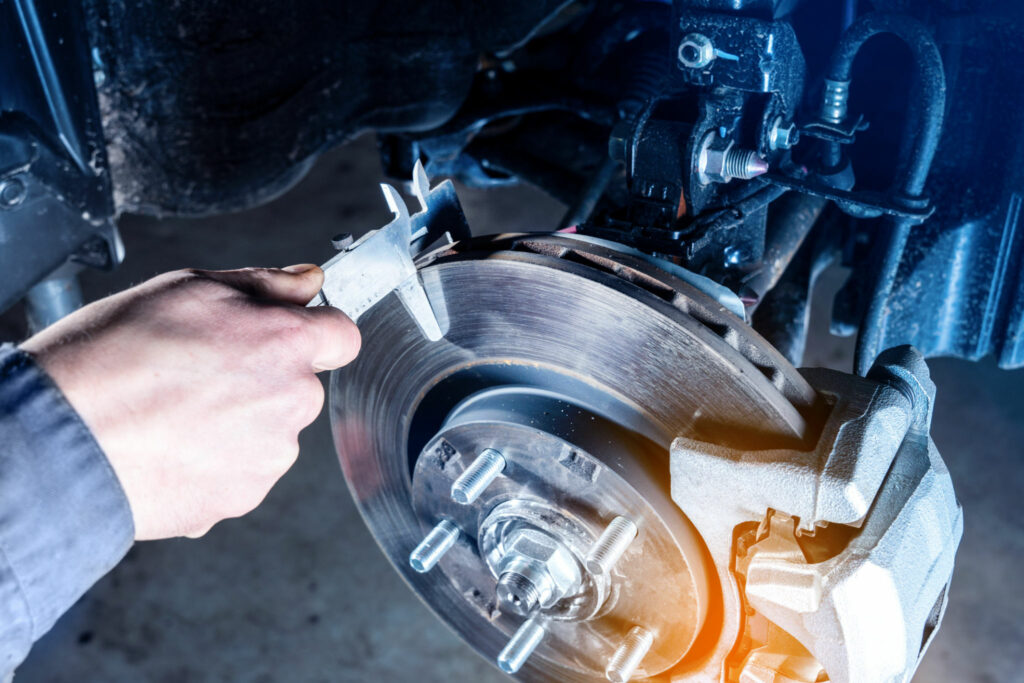MASTERING CAR BRAKE SYSTEM MAINTENANCE: A COMPLETE GUIDE FOR OPTIMAL PERFORMANCE
Key Takeaways
- Understand the critical components of a car braking system and their roles.
- Recognize signs of wear and the need for maintenance or replacement.
- Learn the importance of regular and professional maintenance to ensure the safety and longevity of your vehicle’s braking system.
Importance of Car Braking Systems: Braking systems are vital for vehicle safety, ensuring that you can stop effectively and safely whenever needed. They’re often overlooked, yet they are as crucial as the car’s engine itself. A well-maintained braking system provides the assurance of control and safety on the road.
Overview of Components and Maintenance: Understanding the components of your car’s braking system and their maintenance is key to ensuring its optimal performance. From brake pads to fluid levels, each part plays a unique role in your vehicle’s safety. Regular check-ups and maintenance are crucial for the longevity and effectiveness of these components.
Components of a Car Braking System

Brake Pads and Discs
1. How They Work
Brake pads and discs are the frontline soldiers of the braking system. When you press the brake pedal, hydraulic fluid pushes the pads against the discs, creating friction that slows down your vehicle.
2. Signs of Wear and Replacement
Common signs of wear include a squealing noise, reduced braking efficiency, or a deeper, grinding sound, indicating that the pads are worn down. It’s recommended to replace brake pads every 50,000 miles, but this varies based on driving habits and conditions.
Brake Lines and Hoses
1. Importance of Regular Inspection
Brake lines and hoses are critical for the flow of brake fluid. They need regular inspection for leaks or damage, which can lead to brake failure.
2. Maintenance Tips
Check for any visible damage or leaks. If you notice any fluid on the ground near the wheels, it’s a sign that there might be a leak.
Brake Fluid and Reservoir
1. Role in Performance
Brake fluid is the lifeblood of the braking system, transferring the force from your pedal to the brakes. It’s crucial for the system’s responsiveness.
2. Checking and Topping Off
Check the fluid levels regularly and top off as needed. It’s also important to change the brake fluid every 2 years to maintain its effectiveness.
Types of Car Braking Systems
Disc Brakes
1. Comparison with Drum Brakes
Disc brakes, common in modern cars, consist of a brake disc, calipers, and pads. They offer better heat dissipation than drum brakes, making them more effective, especially in heavy braking scenarios.
2. Advantages and Disadvantages
They provide better stopping power and are easier to maintain but can be more expensive to repair than drum brakes.
Drum Brakes
1. Commonality in Older Vehicles
Drum brakes are found in older models and some rear-wheel brakes. They use brake shoes that press outwards against a rotating drum.
2. Maintenance Tips
Regularly check for wear and adjust the brake shoes as needed. Drum brakes are prone to overheating, so it’s important to monitor them, especially if you frequently drive in hilly areas.
Understanding Different Types of Brake Systems
Disc vs. Drum Brakes: Making the Right Choice
1. Considerations for Selection
When choosing between disc and drum brakes, consider your vehicle type, driving conditions, and personal preferences. Disc brakes are generally preferred for their better heat dissipation and performance.
2. Compatibility with Vehicle
Ensure that the brake system you choose is compatible with your vehicle’s make and model.
Upgrading Your Brake System
1. Performance Upgrades
For those looking to enhance their vehicle’s performance, upgrading to high-performance brake pads, larger discs, or adding more pistons to the brake calipers can be considered.
2. Professional Advice
Always consult with a professional before making any upgrades to ensure compatibility and safety.
Common Braking System Maintenance
A. Regular Inspections
Regular check-ups, including a visual inspection of the brake system, pads, and rotors, can prevent major issues.
B. Signs of Brake Wear
Pay attention to any changes in braking behavior, such as squealing noises, vibrations, or a longer stopping distance.
C. DIY Tips
Simple tasks like checking brake fluid levels and inspecting pads for wear can be done at home. However, more complex tasks should be left to professionals.
Importance of Professional Maintenance
Benefits of Professional Service: Professionals have the tools and expertise to diagnose and fix complex issues, ensuring your brake system functions optimally.
Signs for Professional Maintenance: If you experience any unusual symptoms with your brakes, such as a spongy brake pedal or pulling to one side, it’s time to see a professional.
Preventing Costly Repairs: Regular professional maintenance can help avoid more significant and expensive problems in the future.
Detailed Maintenance Tips for Car Braking Systems
Understanding the essential elements of brake maintenance is pivotal for every vehicle owner. Regular checks and upkeep of crucial components are fundamental to ensure optimal braking performance and overall driving safety. Here are some tips for you-
Brake Pad Inspection and Replacement
Inspection Frequency: Regularly check brake pads for wear. Most pads have a wear indicator that makes a noise when it’s time for replacement.
Replacement Tips: When replacing brake pads, it’s important to choose quality pads that suit your vehicle type and driving habits. Always replace pads in pairs to maintain balanced braking.
Caring for Brake Discs
Inspection for Warping and Damage: Inspect brake discs for any signs of warping or damage. Uneven wear or deep grooves are indicators that the discs need to be replaced or resurfaced.
Importance of Quality Discs: Investing in high-quality brake discs can improve the longevity and effectiveness of your braking system.
Maintaining Brake Lines and Hoses
Checking for Leaks and Damage: Regularly inspect brake lines and hoses for any signs of wear, cracks, or fluid leaks. Even a small leak can significantly impact braking performance.
Replacement Guidelines: Replace any damaged lines or hoses immediately. Use only high-quality replacements to ensure the integrity of the braking system.
By comprehending and addressing these key elements of brake maintenance, drivers can uphold the efficiency and reliability of their vehicle’s braking system, fostering a secure and smooth driving experience on the road.
The Role of Technology in Car Braking Systems
ABS (Anti-lock Braking System)
Functionality: ABS prevents the wheels from locking up during braking, allowing the driver to maintain steering control. This is especially useful in slippery conditions.
Maintenance: While ABS requires minimal maintenance, it’s important to keep the sensors clean and free of debris. A malfunction indicator on the dashboard usually signals ABS issues.
Electronic Brakeforce Distribution (EBD)
How it Enhances Braking: EBD optimally distributes brake force between the front and rear wheels based on load conditions, improving vehicle control and reducing stopping distances.
Maintenance Tips: Regular system diagnostics are recommended to ensure EBD functionality. Any issues usually trigger a warning light on the dashboard.
Professional Brake Maintenance: A Necessity, Not a Luxury
The Expert Touch
Advanced Diagnostics: Professionals use advanced diagnostic tools to accurately assess the condition of your braking system, identifying issues that might be missed in a standard check-up.
Expert Repairs and Replacements: Professional mechanics have the expertise to perform complex repairs and replacements, ensuring that your braking system functions safely and efficiently.
Long-Term Benefits
Extending Brake Life: Regular professional maintenance can significantly extend the life of your braking system, reducing the need for frequent repairs.
Enhancing Safety: With professional care, you can drive confidently, knowing that your braking system is in top condition, ensuring your safety on the road.
Pro Tip: Regular Brake Fluid Checks
Regularly check your brake fluid levels and quality. This simple step can prevent many common braking issues and ensure optimal performance.
FAQ: Your Questions Answered
Q1: How often should I get my brakes checked?
It’s recommended to have your brakes checked at least once a year or every 12,000 miles, whichever comes first.
Q2: Can I replace brake pads myself?
While it’s possible to replace brake pads yourself, it requires a good understanding of car mechanics. If unsure, it’s safer to seek professional help.
Q3: What are the signs of failing brakes?
Key signs include squealing or grinding noises, a soft or spongy brake pedal, and the car pulling to one side when braking.
Q4: How do I know if my brake fluid needs changing?
Brake fluid should be clear to light yellow. If it’s dark or dirty, it needs to be changed.
Q5: How much does it cost to service a brake system?
The cost to service a brake system can vary widely based on several factors, including the vehicle’s make and model, the extent of brake system wear, the quality of replacement parts used, and the labor charges of the mechanic or repair shop. On average, a standard brake service, which may include brake pad replacement, rotor resurfacing or replacement, and brake fluid flush, can range from $100 to $300 per axle. However, more extensive repairs or upgrades can increase the cost significantly. It’s advisable to consult a mechanic or service center for an accurate estimate based on your specific vehicle and its brake system needs.
Conclusion: Safety in Your Hands
In conclusion, understanding and maintaining your car’s braking system is crucial for safe and efficient driving. Regular checks, awareness of wear signs, and professional maintenance are key to keeping your brakes in top condition. Remember, when it comes to braking systems, prevention is always better than cure. Drive safe, and keep those brakes in check!

